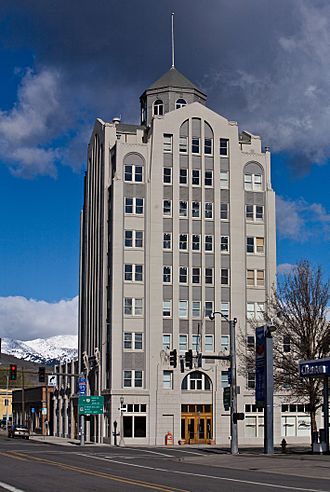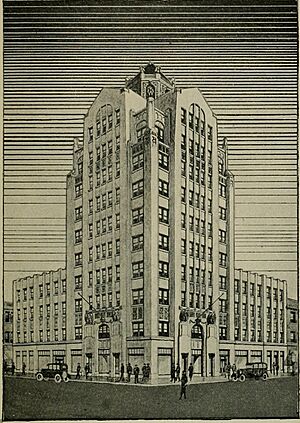Baker City Tower facts for kids
Quick facts for kids Baker Tower |
|
|---|---|

The building's exterior in 2009
|
|
| Former names | Baker Community Hotel Baker Hotel |
| Alternative names | Baker City Tower |
| General information | |
| Opened | August 24, 1929 |
| Cost | $320,000 |
| Height | 144 feet (44 m) |
| Technical details | |
| Floor count | Nine, plus basement and rooftop cupola |
|
Baker Hotel
|
|
|
U.S. Historic district
Contributing property |
|
| Location | 1701 Main Street Baker City, Oregon |
| Built | 1929 |
| Built by | John Almeter |
| Architect | Tourtellotte & Hummel |
| Architectural style | Art Deco |
| Part of | Baker Historic District (ID78002277) |
| Designated CP | December 14, 1978 |
The Baker City Tower or Baker Tower is a famous building in Baker City, Oregon. It was first called the Baker Community Hotel and then the Baker Hotel. It is the tallest building east of the Cascade Range in Oregon.
This nine-story building was built in 1929. It has a cool and unique design style called Art Deco. The Baker Tower is part of the Baker Historic District. It is also listed on the National Register of Historic Places, which means it's an important historical site. The building was designed by the company Tourtellotte & Hummel.
Contents
Building History
Before the Baker Tower was built, there was an old stable on the same spot. This stable was taken down to make room for the new hotel. The Baker Tower is made of concrete. Its main entrance faces Main Street, and there's another entrance on Auburn Avenue.
The top of the building has an eight-sided dome, called a cupola. This cupola was made for people to look out from. From there, you can see amazing views of the Powder River Basin and the Elkhorn Mountains. The building also has cool decorations. These include concrete designs, two large terra cotta eagles at the entrances, and urns on the corners of the eighth floor.
A Hotel for Travelers
The hotel was built to help people traveling long distances by car. Car travel became very popular in the 1920s. This hotel didn't need to be near train tracks, which was new for hotels back then.
The Baker Hotel was meant to be a "community hotel." This meant it was a helpful place for the community and also an investment for local people. About 300 local residents bought shares in the hotel. This made many people in the town feel connected to its success. Even during the Great Depression, a tough economic time, the hotel managed to stay open. It faced some money problems in 1936, but it found a way to get new loans and keep going.
The hotel became famous as "the finest place to dine in eastern Oregon." It even hosted big meetings and events. In 1946, the original owners sold the building. After that, the word "community" was removed from its name.
Changes Over Time
The Baker Tower first opened as an 82-room hotel on August 24, 1929. It stayed a hotel until the late 1960s. In 1969, it closed down for almost two years.
New Uses for the Building
In 1972, a local investor bought the building. They thought it was the "largest and finest building in all Baker." The building was then changed to have shops, offices, and apartments. The first, second, ninth, and tenth floors were used for shops and offices. The other floors became apartments. A few rooms on the second floor were still rented out for people staying overnight.
In 1992, the building was getting old and needed repairs. A big project costing $1.2 million was done to fix it up. It was then changed to provide housing for older adults.
More updates happened in 1999. These included a new elevator, a new heating and cooling system, fire sprinklers, and new windows. Later, the building's original Art Deco decorations were restored. It also got new fiber-optic wiring for fast internet. This helped it be used for modern offices. After a renovation in 2001, the building had shops and offices on the first five floors. The top floors became residential apartments.
Fun Fact
The actors and crew from the 1969 musical movie Paint Your Wagon stayed at the Baker Hotel. Famous actors like Lee Marvin and Clint Eastwood were in the movie. They filmed parts of the movie near Baker City. The hotel was almost completely full just before it closed permanently after the movie production finished.




